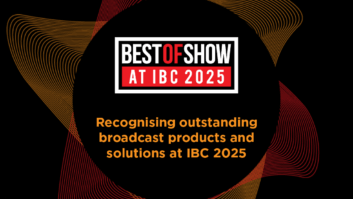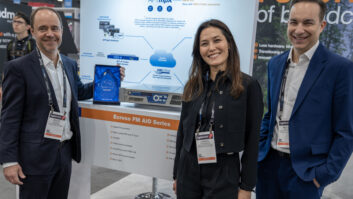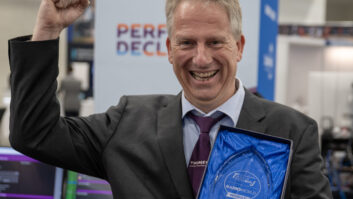In this series we’re talking to audio experts about best practices in audio processing for radio stations.
Geoff Steadman is product manager for Omnia and 25-Seven Systems at Telos Alliance. He worked before that at AKG Acoustics and Orban. He co-founded 25-Seven in 2004.

Radio World: Geoff, what would you consider the most important trends in processing?
Geoff Steadman: We’re watching the role of the processor change over time. More and more, it’s the locus of activity at the transmitter. Today your processor can also be your backup playout system.
It can be the head or tail end of the STL. It’s a host for watermarking, RDS and metadata. It has taken on ancillary jobs that might have been done by an individual device before.
Quality audio processing of course remains the heart of it; and doing this well involves a high barrier to entry. But processing is being asked to do more and more.
It’s my belief that ultimately, the last box standing at the transmitter site will be the transmitter itself. Everything else will be software built into that. Transmitters are the sea turtles of our industry, they have the longest lifespan.
But right now we’re in a kind of “mid transition” toward that outcome. Just as the world hasn’t switched over all at once to electric vehicles, radio is in the process of a longer transition.
I also think of the work we’re doing with Nautel with their software-based air chain, including “Omnia for Nautel” processing, and their HD Test Drive Program. Nautel isn’t trying to be a processor practitioner, and in the broader shift to software, there’s a natural crossover, so they partner with us.
We’re also seeing trends in STLs involving IP protocols. And if you can put fiber at a transmitter site, you do it.
Of course there also are security challenges to deal with, in a world where it’s not practical anymore to just say “We won’t connect anything to the internet.” We need the advantages of connectivity while protecting the technology from bad actors.
That’s one reason our company is investing so much in software development and security.
RW: Do users still come to you looking for hardware?
Steadman: The demand is bifurcated. Major European players want nothing to do with boxes. And in Europe there are mandates to turn off energy-sucking standalone boxes of all kinds. They’re asking how they can put functions onto a single server and “green it up.”
Meanwhile in the United States, demand is more fragmented. We see bigger companies investing in network operation centers and centralization, but I don’t see that at mom-and-pop stations in a big way yet.
Yet we do have to disrupt ourselves. So many things become possible with connectivity, such as diagnostic services. Often, our customer support involves us asking, “Can I get into your system and have a look around?” This becomes more important as traditional broadcast engineers get older. The people coming up in radio technology are more IT-based; we manufacturers have to provide the kind of support they’re comfortable with.
This also prompts us to consider: How do we make a box or application that’s easier to drive, one that does not require a Ph.D. in processing? It needs to be useful to someone who didn’t sit at the knee of an old-timer to learn the nooks and crannies. How can we make it more accessible but put in guardrails on the tuning parameters so they won’t drive their processor off a cliff?
That’s the mindset behind “quick tweak” features in a product like the Omnia Volt; and it is a main part of the design of the Omnia Forza. We’ve got copies of Forza running with Livewire inputs and microMPX output or codec output, all sitting on a Dell server. It’s FM-modulated and it has RDS and watermarking — all the stuff a box does.
This software approach does require a practitioner who’s comfortable with this kind of architecture. But once you go in that direction, you can administer it from 500 miles away without having to visit the site. That’s huge, especially with broadcasters managing more tasks with fewer people.
RW: What kind of user concerns do you hear about processing?
Steadman: The concept of “garbage in, garbage out” applies to all processors. Our sales or support staff will get a complaint that a processor sounds awful, but it turns out the air chain is being fed with junk. In that situation the processor isn’t the culprit, it’s a victim. You can’t expect a processor to fix something once you’ve handicapped what you’re feeding it.
This problem is low-hanging fruit if you want to make your audio sound better. Understand your air chain. Make sure all the pieces are operating to spec. If you’re feeding the front end of your processor with a 25-year-old Compellor, you’re kneecapping it.
Don’t be the person who thinks that if a little processing is good, a lot of boxes all chained together must be great. Modern processors want to receive an unadulterated, pure feed so they can do the best possible job to condition it. We want you to hear the music. We want you to hear the voice. We don’t want you to hear the box.
Our company has an advantage in that Omnia is part of an ecosystem. We know what other boxes in the Telos universe are doing through a kind of built-in cooperation, whether it involves IP audio, metadata or working with our Pathfinder control system. Things that the Omnia team develops may end up in our other products, or vice versa. We get a bump from the economies of scale.
I won’t pretend I’m an AI expert, but there’s also cool stuff ahead in that area — with content detection, with dialog intelligibility, stuff that we’re doing for television at the moment. The monitoring of audio streams will get more powerful and smarter in detecting problems and sending alerts.
And with processing offered as software, the cost of adding it to other products becomes much lower. The big prize with the software model is that we can innovate more quickly.
RW: With consumers now listening on so many types of channels and devices, what philosophy should an engineer adopt about processing?
Steadman: It’s hard to come up with a “one size fits all strategy” but start with quality. How can I avoid stacking compression algorithms? Certainly, no one in this day and age should be using compressed audio libraries on their playlist. Again, we’ll get support calls where someone says “This sounds really awful” and they blame the processor. But whoa, their source files are 96k MP3. Don’t feed the processor garbage. Even more so with low-bandwidth streaming. Watch what you’re feeding the thing.
Read what other experts have to say about on-air processing in your latest free Radio World ebook.







